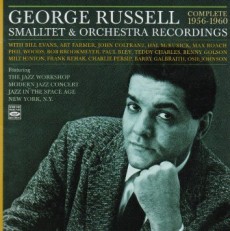
Daily Dose Of Jazz…
George Allen Russell was born on June 23, 1923 in Cincinnati, Ohio, the adopted only child of a nurse and a chef on the B & O Railroad. He sang in the choir of the African Methodist Episcopal Church and listened to the Kentucky Riverboat music of Fate Marable and made his stage debut at age seven, singing “Moon Over Miami” with Fats Waller.
Surrounded by the music of the black church and the big bands played on the Ohio Riverboats, he started playing drums with the Boy Scouts and Bugle Corps, receiving a scholarship to Wilberforce University. There he joined the Collegians, a band noted as a breeding ground for great jazz musicians including Ben Webster, Coleman Hawkins, Charles Freeman, Frank Foster and Benny Carter. He was a member noted jazz composer, Ernie Wilkins. When called up for the draft at the beginning of WWII he was hospitalized with tuberculosis where he was taught the fundamentals of music theory by a fellow patient.
Following his release from the hospital, he played drums with Benny Carter’s band, but after hearing Max Roach decided to give up drumming as a vocation. Inspired by hearing Thelonious Monk’s Round Midnight, George moved to New York in the early Forties and became a member of a coterie of young innovators who frequented the 55th Street apartment of Gil Evans. This clique included Miles Davis, Charlie Parker, Gerry Mulligan and John Lewis.
Back to the hospital in 1945 for 16 months with another bout of tuberculosis Russell worked out the basic tenets of what was to become his Lydian Chromatic Concept of Tonal Organization. This was his theory encompassing all of equal-tempered music which has been influential well beyond the boundaries of jazz. At that time, Russell’s ideas were a crucial step into the modal music of John Coltrane and Miles Davis on his classic recording, Kind Of Blue, and served as a beacon for other modernists such as Eric Dolphy and Art Farmer.
George would go on to compose Cubano Be,Cubano Bop for the Dizzy Gillespie Orchestra, becoming the pioneering experiment of fusing bebop and Cuban jazz elements. The following year he composed A Bird In Igor’s Yard in tribute to Charlie Parker and Igor Stravinsky and recorded at a session led by Buddy DeFranco. He would start playingpiano and go on to work with Artie Shaw, Bill Evans, Art Farmer, Hal McCusick, Barry Galbraith, Milt Hinton, Paul Motian, Paul Bley, Jon Hendricks, Bob Brookmeyer, Steve Swallow, Dave Baker, Eric Dolphy, Sheila Jordan, Tom Harrell, Ray Anderson and numerous and others.
Russell recorded his debut album as a leader, Jazz Workshop, playing very little but masterminding the events of the session in the same vein as Gil Evans. He was to record a number of impressive albums over the next several years, sometimes as primary pianist.
Over the course of his career he would be commissioned to compose a piece for Brandeis University and Swedish Radio for the Radio Orchestra, tour Europe, live in Scandinavia, assume the presidency of the New England Conservatory of Music and was appointed to teach the Lydian Concept in the newly created jazz studies department. He continued to compose major orchestral and chorus works, earned two Grammy nominations for his 45-minute opus The African Game, and toured with a group of American and British musicians, resulting in The International Living Time Orchestra, a group comprised of Dave Bargeron, Steve Lodder, Tiger Okoshi, Brad Hatfield, and Andy Sheppard, who still tour and perform today.
He received a MacArthur Foundation Genius Grant, NEA American Jazz Master Award, two Guggenheim Fellowships and a British Jazz Award. He taught throughout the world, and was a guest conductor for German, Italian, Danish, Finnish, Norwegian, and Swedish radio groups. Pianist, composer, arranger and theorist George Russell died of complications from Alzheimer Disease in Boston, Massachusetts on July 27, 2009.
More Posts: piano


